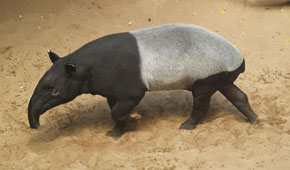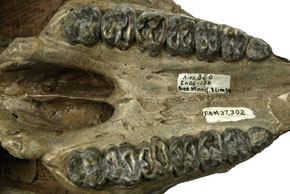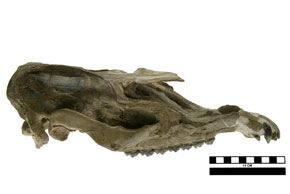Tapiridae

Pictured left: Malayan tapir (Tapirus indicus). James Dowling-Healey
Tapiridae: Members of the tapir family have been present in the fossil record for at least 41 million years, first appearing in the middle Eocene. While many families of perissodactyls achieved very high levels of diversity, there have never been more than a few species of tapirs. Tapirs are also morphologically conservative - their teeth and skeletons resemble those of early ceratomorphs, and some have referred to them as living fossils. The skull, on the other hand, is very specialized with many unique features related to the development of the proboscis. The four living species of tapirs use the prehensile proboscis to browse selectively on leaves, sprouts, and small branches, including aquatic plants, and also ingest a great deal of fruit and seeds.
While modern tapir species are confined to tropical forests of South America and Asia, they originated and persisted for many millions of years in more northern regions, even during the ice ages, although their rarity as fossils suggests favorable habitats may have been scarce. Recently a huge fossil accumulation of late Miocene tapirs was discovered near Gray, Tennessee. It is the largest accumulation of fossil tapirs in the world and suggests that tapirs were once very common in some parts of North America.


Left: Ventral view of skull Tapirus johnsoni (AMNH 37302) showing dentition. Victoria Healy/AMNH. Right: Skull of the Miocene tapir Tapirus johnsoni (AMNH 37302) from Cherry County, Nebraska. Victoria Healy/AMNH.
